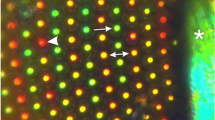Abstract
THE compound eye of the firefly is the one outstanding example which shows evidence of an image which is formed by the combination of rays that have entered by several facets. The original account by Exner1 includes a description and photograph of the erect image that can be found behind the cleaned cornea of the firefly Lampyris. This image has been confirmed by others2 and a theoretical explanation of it supposes that an inverted first image is formed within each corneal cone by the curvature of its front surface and that an erect second image is then formed by the curved surface of the proximal tip of the corneal cone3. The erect superposition image, however (which undoubtedly exists if the cornea is well cleaned), does not lie in the place of the receptors4 and there is no evidence that it has a functional significance. In fact, the superposition theory depends on the unlikely existence of an optically homogeneous and transparent region between the cornea and the layer of receptors. Despite its importance to the theory, the anatomy of the firefly retina remains unknown. The following account, based on Photuris versicolor, points to the conclusion that the superposition theory is applicable only to a cleaned cornea because the actual anatomy suggests quite a different optical system.
Similar content being viewed by others
References
Exner, S., Die Physiologie der facettierten Augen von Krebsen und Insekten (Verlag Fr. Deuticke, Leipsig und Wien, 1891).
Animal Behaviour (edit. by Tinbergen, N.) (Time-Life International, 1966).
Winthrop, J. T., and Worthington, C. R., Biophys. J., 6, 124 (1966).
Nunnemacher, R. F., in Progress in Photobiology, Proc. Third Intern. Cong. Photobiol. (edit. by Christensen, C., and Buchmann, B.), 428 (Elsevier, Amsterdam, 1961).
Kuiper, J. W., Symp. Soc. Exp. Biol., 26, 58 (1962).
Horridge, G. A., in The Functional Organization of the Compound Eye (edit. by Bernhard, C. G.), 513 (Pergamon Press, 1965).
Author information
Authors and Affiliations
Rights and permissions
About this article
Cite this article
HORRIDGE, G. Pigment Movement and the Crystalline Threads of the Firefly Eye. Nature 218, 778–779 (1968). https://doi.org/10.1038/218778a0
Received:
Issue Date:
DOI: https://doi.org/10.1038/218778a0
- Springer Nature Limited
This article is cited by
-
A discussion of light scattering in the Squilla rhabdom
Kybernetik (1973)
-
Comparative studies of arthropod superposition eyes
Zeitschrift f�r Vergleichende Physiologie (1972)
-
Les photor�cepteurs des Collemboles, �tude ultrastructurale
Zeitschrift f�r Zellforschung und Mikroskopische Anatomie (1971)
-
Bau und Funktion des Komplexauges der Schmei�fliege
Die Naturwissenschaften (1971)





